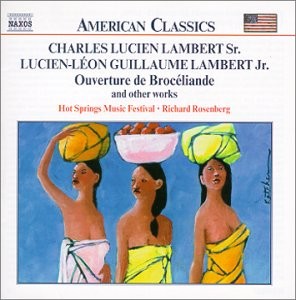Home
Blog
Composers
Musicians
Black History
Audio
About Us
Links
Composers:
Adams, H. Leslie
Akpabot, Samuel Ekpe
Alberga, Eleanor
Bonds, Margaret Allison
Brouwer, Leo
Burleigh, Henry Thacker
Coleridge-Taylor, Samuel
Cunningham, Arthur
Dawson, William Levi
Dede, Edmund
Dett, R. Nathaniel
Elie, Justin
Ellington, Edward K. "Duke"
Euba, Akin
Garcia, José Mauricio Nunes
Hailstork, Adolphus C.
Holland, Justin
Jeanty, Occide
Johnson, James Price
Joplin, Scott
Kay, Ulysses Simpson
Khumalo, Mzilikazi
Lambert, Charles Lucien, Sr.
Lambert, Lucien-Leon G., Jr.
Lamothe, Ludovic
Leon, Tania
Moerane, Michael Mosoeu
Perkinson, Coleridge-Taylor
Pradel, Alain Pierre
Price, Florence Beatrice Smith
Racine, Julio
Roldan, Amadeo
Saint-Georges, Le Chevalier de
Sancho, Ignatius
Smith, Hale
Smith, Irene Britton
Sowande, Fela
Still, William Grant
Walker, George Theophilus
White, José Silvestre
Williams. Julius Penson
AfriClassical Blog
Companion to AfriClassical.com
Guest Book
William J. Zick, Webmaster,
wzick@ameritech.net
©
Copyright 2006 - 2022
William J. Zick
All rights reserved for all content of AfriClassical.com
|
Home ->
Composers -> Lambert, Charles
Lucien, Sr.
Français
1 Father
Charles Lucien Lambert, Sr. and his
half-brother Sidney Lambert were the sons of Edmund Dede's early
music teacher, Charles Richard Lambert. They too received
their first piano lessons from their father. The
compositions of Charles Lucien Lambert, Sr. have been revived by
the Hot Springs Music Festival, led by Richard Rosenberg,
Conductor, on Naxos 8.559037 (2000).
2 Birth
Lester Sullivan, University Archivist
at Xavier University in New Orleans wrote one of the liner notes
of the CD:
|
Lucièn was born in New Orleans about 1828 or 1829. His mother appears to have been a Louisiana free Creole of colour. Charles Richard died in 1862, while he and Sidney were in Port-au-Prince, Haiti. |
3 Racial
Hostility
Sullivan goes on to explain that
racial hostility caused Charles Lucien Lambert and his
half-brother to find work away from New Orleans:
|
The careers of Lucièn and Sidney extended far beyond their hometown. Like the white Creole Louis Moreau Gottschalk, they could not remain long in New Orleans. Lucièn, some ten years
older than Sidney, was a contemporary of Gottschalk and, in fact, Louis Moreau and Lucièn enjoyed a friendly artistic rivalry as aspiring virtuoso pianists and
composers. |
4 Paris
The liner notes by Lester Sullivan
report that Lucièn was living in Paris in 1854, according to the
newspaper L'Illustration. Sullivan continues:
|
Also in 1854, his earliest piece held at the French Bibliothèque Nationale,
L'Angélus au monastère: Prière, for
piano, was published. The publisher
of his piano Variations et Final sur l'air Au clair de la lune, Op. 30 (1859) had to reprint it five times to meet its sales. From the start, Lucièn was more successful than Dédé in securing publication in Paris. Then, in 1858, just outside the city, his son Lucièn-Léon Guillaume was born. |
5 Rio de Janeiro
Charles Lucien Lambert relocated to Brazil
with his family, we learn from the liner notes by Lester
Sullivan:
|
Charles Lucièn moved his family to
Brazil sometime in the 1860s. In Rio de Janeiro he
opened a piano and music store and taught music,
eventually becoming a member of the Brazilian National
Institute of Music. In 1869, Gottschalk arrived in Rio
for a series of spectacular
appearances, fated to be his last.
Lucièn Jr., then not yet a teenager, and his father,
both performed in at least one of Gottschalk's monster
concerts, in which 31 pianists played simultaneously. |
6 Ernesto Nazareth
Sullivan tells of Charles Lucien Lambert's
friendship with the family of the young Ernesto Nazareth, who
was to become one of his country's important composers:
|
Lucièn Sr. eventually became a good
friend of the family of the young Ernesto Nazareth
(1863-1934) and that great Brazilian composer's first
professional teacher. Now that Nazareth's piano music is
enjoying a revival on recordings, it becomes
increasingly evident that he may have gained from
Lambert not only his love for Chopin but also an inclination towards the pianola style, which, coupled with Gottschalk's example in the area of
local colour, suggests a line of influence from Lambert
Sr. and Gottschalk to Nazareth and thence to Heitor
Villa-Lobos and even Darius Milhaud. |
7 Works
Prof. Dominique-René de Lerma
Ah, vous disais-je maman, for piano.
Au claire de la lune, op. 30. New York: Johnson
Reprint Corporation, 1968 (Music and some highly musical
people, by James M. Trotter, p69-80 [appendix]).
Cloches et clochettes.
Étude-mazurka.
La brésiliana.
La flamenca, opera in 4 acts (1899). Paris:
Choudens, 1903. 266p. (piano-vocal score) (#A.C. 11692) Text:
Henri Cain and Eugène Edward Adenis. Première: Théâtre
Municipal, Paris. Library: Library of Congress.
La juive.
La rose et le Bengali.
L'américaine.
Le départ du conscript; fantaisie-marche.
Le niagara.
Les ombre aimées.
Paris, Vienne.
Pluie de corails.
This page was last updated
on
March 5, 2022
|

